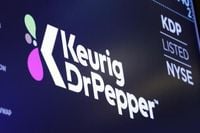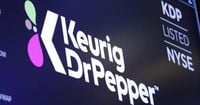In a move that’s set to shake up the global beverage landscape, Keurig Dr Pepper has announced a landmark acquisition of Dutch coffee powerhouse JDE Peet’s for a staggering $18 billion (€15.7 billion). The deal, revealed on August 25, 2025, is not just another big-ticket buyout in the ever-evolving food and drink sector. It marks the unwinding of the 2018 merger between Keurig and Dr Pepper, splitting the company into two sharply focused giants: one for coffee and one for soft drinks.
According to The Associated Press, the agreement will see Keurig Dr Pepper’s coffee assets—think Green Mountain Coffee, Swiss Miss, Tully’s Coffee, and Caribou Coffee—merged with JDE Peet’s stable of more than 50 brands, including Peet’s Coffee, Douwe Egberts, Kenco, and L’OR. The result? A new entity called Global Coffee Co., with a footprint spanning over 100 countries and annual net sales projected at $16 billion. On the other side, Beverage Co. will take up the mantle for soft drinks, focusing on familiar names like Dr Pepper, Snapple, 7UP, and Schweppes, as well as fast-growing energy and hydration drinks such as Ghost, C4, and Electrolit.
Tim Cofer, currently CEO of Keurig Dr Pepper, will head up Beverage Co. He called the move “a transformational moment in the beverage industry,” adding in a joint news release, “By creating two sharply focused beverage companies with attractive and tailored growth propositions and capital allocation strategies, we are poised to generate significant shareholder value in both the near and long term.”
Meanwhile, Sudhanshu Priyadarshi, Keurig Dr Pepper’s chief financial officer, is set to lead Global Coffee Co., which will have its headquarters in Burlington, Massachusetts, and international operations based in Amsterdam. Both companies will be listed in the United States, underlining the global ambitions of the new structure.
The strategic rationale is clear: Keurig Dr Pepper aims to seize a larger slice of the $400 billion global coffee market and the $300 billion North American refreshment market. The move comes as the company’s U.S. coffee sales slipped 0.2% last quarter to $900 million, as reported by CNBC. With coffee prices soaring due to droughts in Brazil and Vietnam and the U.S. imposing a hefty 50% tariff on Brazilian coffee imports in July 2025—citing political tensions in Brazil—the timing for consolidation couldn’t be more critical.
JDE Peet’s CEO Rafa Oliveira praised the merger, stating, “We are incredibly proud of the formidable global platform that we have built at JDE Peet’s and, together with Keurig, we are looking forward to powering a new era of coffee innovation and leadership, building on JDE Peet’s recently announced ‘Reignite the Amazing’ strategy.”
The deal is also expected to deliver significant cost savings. As reported by Reuters, the companies anticipate saving around $400 million over three years by combining operations and leveraging their joint buying power. ING analyst Maxime Stranart noted that the new Global Coffee Co. will be comparable in size to Nestlé’s coffee business, each accounting for around 20% of the global coffee market.
But not everyone is convinced the massive restructuring is a slam dunk. Investors reacted swiftly, with Keurig Dr Pepper’s share price tumbling 11% following the announcement. Concerns centered around the company’s plan to finance the acquisition with a mix of cash and debt, as well as the complexity of executing a two-step transaction. S&P Global responded by placing Keurig Dr Pepper on a credit watch with negative implications, citing worries about increased debt and the challenges inherent in splitting the company.
During a conference call with investors, Cofer sought to reassure stakeholders, explaining, “Following the separation, each stand-alone entity will lead its industry with a sharp strategic focus and with operating models that are finely calibrated to their unique categories and markets.” He emphasized that the combination with JDE Peet’s would extend Keurig’s reach far beyond North America, tapping into fast-growing coffee markets in Europe and emerging economies. In fact, the company projects that 40% of Global Coffee Co.’s sales will come from North America, another 40% from Europe, and the remaining 20% from emerging markets.
Industry analysts, such as Jon Cox of Kepler Cheuvreux, see the logic in rolling the two coffee businesses together. “Reducing the European-centric and commoditised nature of most of JDE Peet’s business, and giving Keurig international exposure, makes sense,” Cox told Reuters. The combined coffee giant will be better positioned to compete with heavyweights like Nestlé and Starbucks, especially as demand for coffee continues to climb globally—even outpacing population growth, according to Cofer.
The move also reflects broader trends in the food and beverage world, where legacy brands are scrambling to adapt to shifting consumer tastes and market pressures. In recent years, Kellogg split into two companies, Mars bought Kellanova, and Ferrero announced plans to acquire WK Kellogg. Even struggling Kraft Heinz has been rumored to consider a split. Meanwhile, big players are snapping up fast-growing niche brands: PepsiCo’s acquisition of Poppi and Keurig Dr Pepper’s own recent purchase of Dyla, a maker of powdered drink mixes, are just the latest examples.
Once the dust settles, Beverage Co. will be based in Frisco, Texas, while Global Coffee Co. will anchor its U.S. base in Burlington, Massachusetts, with its international HQ in Amsterdam. The split is expected to be completed by the end of 2026, with the initial acquisition set to close in the first half of that year.
In the words of Tim Cofer, “We like, and I like, the coffee category. Why? It’s huge. It’s ubiquitous. Obviously, we’ve up to this point focused on North America. But the global data shows coffee is consistently growing on a volume basis above population.”
With the beverage industry at a crossroads—facing rising commodity prices, shifting health trends, and volatile geopolitics—Keurig Dr Pepper’s bold move could set the tone for the next era of competition. Whether the new giants will deliver on their promise remains to be seen, but one thing’s for sure: the world’s morning routines and afternoon pick-me-ups may never be quite the same again.

